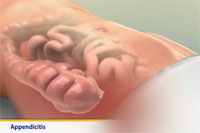
Appendicitis
What is appendicitis?
Appendicitis is an inflammation of the appendix. The appendix is a small, finger-shaped pouch where the large and small intestines join. Scientists are not sure what the appendix does, if anything. But when it is inflamed, it gets swollen and painful and can cause serious problems.
It is important to get treatment for appendicitis before the appendix ruptures. A rupture is a break or tear in the appendix. If an infected appendix breaks open, infection and bowel movement may spread inside the abdomen. This can cause a life-threatening infection of the belly called peritonitis.
Because of the risk of rupture, appendicitis is considered an emergency.
How does it occur?
In most cases, appendicitis is caused by a blockage of the opening of the appendix by a piece of stool. Sometimes it is caused by infection in the digestive tract.
Appendicitis is a common reason for emergency abdominal surgery in children. Most surgeries are done in children who are between 8 to 16 years of age. It is slightly more common in boys than girls.
What are the symptoms?
The most common symptoms include:
- constipation or diarrhea
- loss of appetite
- mild fever
- nausea
- pain that usually starts around the bellybutton and then moves to the lower right side of the belly. The pain usually gets worse when moving, taking deep breaths, coughing, sneezing, or passing gas. The pain may be hard for young children to describe.
- swollen, tight, or hard abdomen
- urinating frequently and pain with urination
- vomiting.
Not all children have all of these symptoms.
How is it diagnosed?
Sometimes it is difficult to diagnose appendicitis in young children. Your healthcare provider will review your child's symptoms and do an exam. Your child may have the following tests:
- blood tests
- urine tests
- X-ray or ultrasound exam of the belly.
How is it treated?
Children receive antibiotics both before and after surgery. When the appendix is inflamed, it must be removed. The operation is called an appendectomy. There are 2 kinds of surgery: laparoscopic or open surgery. In laparoscopic surgery, the doctor makes a tiny cut in your child's abdomen and inserts the laparoscope through the cut. A laparoscope is a thin metal tube with a light and tiny camera. Other tiny cuts are made to place tools used during the operation. The surgeon removes the appendix with a tool that can cut tissue and stop bleeding. An open surgery involves one larger cut in the lower right side of the belly.
A rupture of the appendix can also cause an abscess (infected sore) near the place where the appendix ruptured. If the appendix does rupture, the surgeon may put a drainage tube in the abdomen to let the infection drain for a few days after surgery.
What should I expect after surgery?
Your child may receive fluids and antibiotics through an IV line. Some children are wide awake almost immediately. Other children are groggy for hours. Your child may feel sick to his stomach when waking up after surgery. Food or drinks are not given until gas or stool is passed. Then your child is given clear liquids. If your child is able to take clear liquids without nausea or vomiting, he will be allowed to eat regular food.
Taking deep breaths and sitting up can help speed up recovery. Once your child is no longer sleepy, he will be encouraged to get up and walk around the room and hallway.
If the appendix has not ruptured, most children are able to go home within 24 to 48 hours after it is removed and to school in about 1 week. A child who has had a ruptured appendix is usually in the hospital for at least 4 to 5 days.
How do I care for my child at home?
Keep the surgery site clean and dry for at least 2 days after surgery. There are difference kinds of dressings that can be used on your child's wound.
- If your child has Steri-Strips only, they will fall off on their own.
- If your child has a glue-like covering over the incision, the glue will also come off by itself.
- If your child's wound was left open, you will be taught how to change the bandages at home. Children may take showers 2 days after surgery, but should not take baths for 1 week. Gym class, sports, and climbing games should be avoided for 2 to 4 weeks after surgery.
Children can live a normal life without an appendix.
When should I call my child's healthcare provider?
Call your provider if:
- Your child has a lot of swelling or bleeding from the incisions.
- Your child has pain even after taking pain medicine.
- Your child vomits or develops diarrhea.
- Your child's incision looks infected (red, puffy, green or yellow drainage).
- Your child's temperature is above 101.5° F (38.6° C).
Last modified: 2010-05-21
Last reviewed: 2010-03-02

